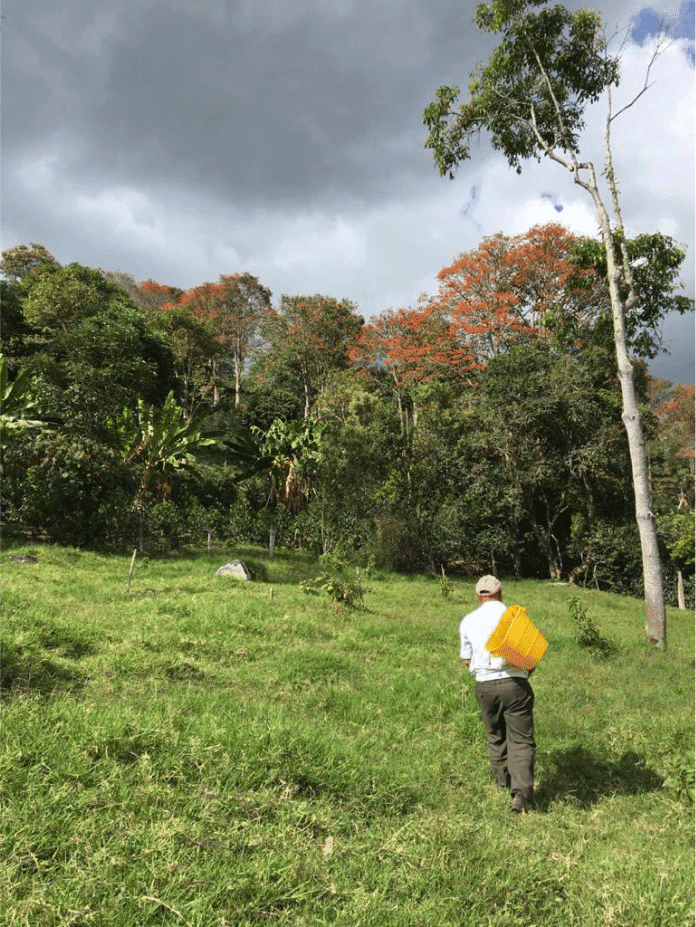It starts with a seed


Monkaaba
Colombia
In 2018, Brendan of Semilla had the pleasure of meeting and travelling for two weeks with the young producer Esnaider Ortega-Gomez, from San Agustin Huila. SInce that trip that crossed Southern Huila and on up into Tolima, they’ve developed a strong friendship and have shared many long conversations on the state of specialty coffee for the smallholder grower in Colombia, and around the world.
History Doesn't Happen, It Is Made
Monkaaba is a collectivist project founded by a seven smallholder families, and led on a daily basis by Esnaider Ortega Gomez and Didier Ortega. Originally, this project was based out of is currently based out the Ortega-Gomez home in the vereda of Sevilla, outside San Agustin. Based on the principles of open access and community support, every weekend during harvest time, their home was opened to any smallholder who wanted free sample roasting and cupping with the aim of providing unbiased and clear feedback and recommendations around quality. From our original purchase in 2020 of six producers, the Monkaaba project has blossomed into a tight-knit network of 60 families, all of whom are driven by an interest to know more about their coffee, how it might be improved, and how they can form resilient, stable relationships. It may surprise the coffee drinker and even the specialty coffeee professional to know that the vast majority of Colombian smallholders, despite all their nation’s fame as a coffee producing country, still find themselves locked out of a market that would offer them a basically sustainable price. Indeed, even by the National Coffee Grower Federation’s (FNC) own numbers, only about 2% of the country's coffee is sold outside of the commercial market. San Agustin has a long and storied history of coffee production, being one of the first areas to participate in the Federacion Nacional de Cafeteros (FNC). There are some 6,000 growers in this area, and yet the vast majority continue to sell their coffees either for market prices or en verde for about half of market price.
The Monkaaba project is made up of many smallholders with the same stories. Around 60% of these growers are underthe age of 35, and sold primarily in on the local "black market" either in wet or dry parchment. The remaining 40% have had some access to the specialty market, but never with year over year guarantees, nor with transparency and respect.
Esnaider and other storied growers like Agusto Ortega, Daniel Munoz, and Jaime Burbano wanted to create a new structure that supported smallholders to improve their knowledge, quality, and profitability through pedeagogical support. When Esnaider asked us to accompany him in this project, we didn’t hesitate to support. To work with our friends, while also being able to focus on finding impeccable quality from producers who need a solid buyer, is exactly what Semilla was created to do.
Esnaider has long expressed his lament that many producers who bring coffee in to specialty buying points are simply met with unexplained rejection based on a cupping score, with little to no information on why it received this score or more importantly, what could be done to improve it. Monkaaba's answer to this is simple - you bring your sample, and cup it with us blind. Whatever the result, you'll be in the room to hear it and receive the feedback necessary to deal with any issue that appears.
Building Alternatives
In some ways, we can’t help but make the observation of how producers’ experience struggling to find a market alternative is in fact the sharp edged of the double edged sword that is the FNC’s fixed price guarantee. Namely, that when a producer wishes to step outside of this traditional system of selling their coffee, it will require financial risk that they are likely not prepared for due to the fact that they have been receiving prices that likely don’t actually cover their costs of production. Even more difficult, when a smallholder attains a certain level of income, they lose their access to public healthcare and education, thereby incentivizing poverty via sale on the black market where coffees are sold without paperwork. We talked about this on our blog two years ago, but the same pattern is still evident. As many producers don’t take into account all of their costs, specifically their own labour inputs, they may not be aware of the fact that they are losing money selling at local market prices. In a way, this system is creates a dependence that doesn’t grant autonomy, which is the opposite of that which we wish to see amongst our producer partners. Even if producers do take stock of their costs, should they not have a buying point accept their coffees at a higher price than market, they have no option but to accept this low price. And in a country like Colombia, where coffee growing has been promoted as a monoculture crop to be grown at volume rather than for quality, there is zero risk management strategy in place should these crops fail.
Again, we can see how despite Colombia’s fame as a coffee producing country, the thousands of producers who have made this fame possible continue to live in a position of struggling to get by thanks to a national industry that pursues volume to enrich the most powerful.
Indeed, many of our recent conversations with Esnaider have centred around the troubling trend he sees in Colombia that seeks to squash the artisenal small producer, and specialty will play no small part in that.
In an ecosystem like Colombia’s, it’s becoming more and more common that producers who make it on the specialty market aren’t generational small producers but are instead wealthy landowners who buy cherry from other small producers and/or have the education, budget and financial flexibility to engage in experimental processes to sell for high ticket prices.

